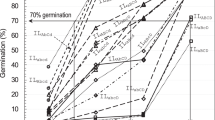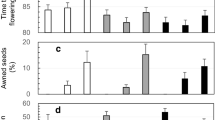Abstract
Seed dormancy in rice interrelates to the weedy characteristics shattering, awn, black hull color, and red pericarp color. A cross between the weedy strain SS18-2 and the breeding line EM93-1 was developed to investigate the genetic basis and adaptive significance of these interrelationships. These characteristics or their components differed in average degree of dominance from −0.8 to 1.5, in heritability from 0.5 to 0.96, and in their contribution to phenotypic or genotypic variation in dormancy by up to 25%. Five dormancy, four shattering, and three awn-length quantitative trait loci (QTLs) were detected in the BC1 population replicated in 2 years. Two QTLs for hull color were identified, and the SS18-2-derived and EM93-1-derived alleles increased the intensity of black, and red or yellow pigmentations, respectively. The only QTL for pericarp color co-located with the red pericarp gene Rc, with the SS18-2-derived allele increasing the intensity of black and red pigmentations. Four of the five dormancy QTLs were flanked or bracketed by one to four QTLs for the interrelated characteristics. The QTL organization pattern indicates the central role of seed dormancy in adaptive syndromes for non-domesticated plants, implies that the elimination of dormancy from cultivars could arise from the selections against multiple interrelated characteristics, and challenges the use of dormancy genes at these loci in breeding varieties for resistance to pre-harvest sprouting (PHS). However, another QTL (qSD12) provides candidate gene(s) for PHS resistance because it has a large effect in the population and it is independent of the loci for interrelated characteristics.




Similar content being viewed by others
References
Anderson JA, Sorrells ME, Tanksley SD (1993) RFLP analysis of genomic regions associated with resistance to pre-harvest sprouting in wheat. Crop Sci 33:453–459
Bres-Patry C, Lorieu M, Clement G, Bangratz M, Ghesquiere A (2001) Heredity and genetic mapping of domestication-related traits in a temperate japonica weedy rice. Theor Appl Genet 102:118–126
Burke JM, Tang S, Knapp SJ, Rieseberg LH (2002) Genetic analysis of sunflower domestication. Genetics 161:1257–1267
Cai HW, Morishima H (2000) Genomic regions affecting seed shattering and seed dormancy in rice. Theor Appl Genet 100:840–846
Cai HW, Morishima H (2002) QTL clusters reflect character associations in wild and cultivated rice. Theor Appl Genet 104:1217–1228
Chang TT, Yen ST (1969) Inheritance of grain dormancy in four rice crosses. Bot Bull Acad Sin 10:1–9
Devos KM, Gale MD (2000) Genome relationships: the grass model in current research. Plant Cell 12:637–646
Doebley J, Stec A (1991) Genetic analysis of the morphological differences between maize and teosinte. Genetics 129:285–295
Dong Y, Tsozuki E, Kamiunten H, Terao H, Lin D, Matsuo M, Zheng Y (2002) Identification of quantitative trait loci associated with pre-harvest sprouting resistance in rice (Oryza sativa L.). Field Crops Res 81:133–139
Flintham JE, Adlam R, Bassoi M, Holdsworth M, Gale MD (2002) Mapping genes for resistance to sprouting damage in wheat. Euphytica 126:39–45
Frary A, Nesbitt TC, Frary A, Grandillo S, Knaap E, Cong B, Liu J, Meller J, Elber R, Alpert KB, Tanksley SD (2000) fw2.2: a quantitative trait locus key to the evolution of tomato fruit size. Science 289:85–88
Gale MD, Flintham JE, Devos KM (2002) Cereal comparative genetics and preharvest sprouting. Euphytica 126:21–25
Gfeller F, Svejda F (1960) Inheritance of post-harvest seed dormancy and kernel colour in spring wheat lines. Can J Plant Sci 40:1–6
Grist DH (1986) Rice, 6th edn. Longman, London
Groos C, Gay G, Perretant MR, Gervais L, Bernard M, Dedryver F, Charmet G (2002) Study of the relationship between pre-harvest sprouting and grain color by quantitative trait loci analysis in a white × red grain bread-wheat cross. Theor Appl Genet 104:39–47
Gu X-Y, Chen Z-X, Foley ME (2003) Inheritance of seed dormancy in weedy rice. Crop Sci 43:835–843
Gu X-Y, Kianian SF, Foley ME (2004) Multiple loci and epistases control genetic variation for seed dormancy in weedy rice (Oryza sativa). Genetics 166:1503–1516
Gu X-Y, Kianian SF, Foley ME (2005) Seed dormancy imposed by covering tissues interrelates to shattering and seed morphological characteristics in weedy rice. Crop Sci 45 (in press)
Han F, Ullrich SE, Clancy JA, Jitkov V, Kilian A, Romogosa I (1996) Verification of barley seed dormancy loci via linked molecular markers. Theor Appl Genet 92:87–91
Harlan JR (1965) The possible role of weed races in the evolution of cultivated plants. Euphytica 14:173–176
Harlan JR, de Wet JMJ (1965) Some thoughts about weeds. Econ Bot 19:16–24
Harlan JR, de Wet JMJ, Price EG (1973) Comparative evolution of cereals. Evolution 27:311–325
Johnson LPV (1935) The inheritance of delayed germination in hybrids of Avena fatua and A. sativa. Can J Res 13:367–387
Kato K, Nakamura W, Tabiki T, Miura H (2001) Detection of loci controlling seed dormancy on group 4 chromosomes of wheat and comparative mapping with rice and barley genomes. Theor Appl Genet 102:980–985
Kearsey MJ, Pooni HS (1996) The genetical analysis of quantitative traits. Chapman and Hall, London
Khan M, Cavers PB, Kane M, Thompson K (1996) Role of the pigmented seed coat of proso millet (Panicum miliaceum L.) in imbibition, germination and seed persistence. Seed Sci Res 7:21–25
Kinoshita T (1984) Gene analysis and linkage map. In: Tsunoda S, Takahashi N (eds) Biology of rice. JSSP/Elsevier, Tokyo, pp 187–274
Li C, Ni P, Francki M, Hunter A, Zhang Y, Schibeci D, Li H, Tarr A, Wang J, Cakir M, Yu J, Bellgard M, Lance R, Appels R (2004) Genes controlling seed dormancy and pre-harvesting sprouting in a rice-wheat-barley comparison. Funct Integr Genomics 4:84–93
Lijavetzky D, Martinez MC, Carrari F, Hopp HE (2000) QTL analysis and mapping of pre-harvest sprouting resistance in sorghum. Euphytica 112:125–135
Lin SY, Sasaki T, Yano M (1998) Mapping quantitative trait loci controlling seed dormancy and heading date in rice. Theor Appl Genet 96:997–1003
Lincoln S, Daly M, Lander E (1992) Constructing genetic maps with mapmaker/exp 3.0, 3rd edn. Whitehead Institute, Cambridge
Matus I, Corey A, Filichkin T, Hayes PM, Vales MI, Kling J, Riera-Lizarazu O, Sato K, Powell W, Waugh R (2003) Development and characterization of recombinant chromosome substitution lines (RCSLs) using Hordeum vulgare subsp. spontaneum as a source of donor alleles in a Hordeum vulgare subsp. vulgare background. Genome 46:1010–1023
McCouch SR, Teytelman L, Xu Y, Lobos KB, Clare K, Walton M, Fu B, Maghirang R, Li Z, Xing Y, Zhang Q, Kono I, Yano M, Fjellstrom R, DeClerck G, Schneider D, Cartinhour S, Ware D, Stein L (2002) Development and mapping of 2240 new SSR markers for rice (Oryza sativa L.). DNA Res 9:199–207
Miura K, Lin SY, Yano M, Nagamine T (2002) Mapping quantitative trait loci controlling seed longevity in rice (Oryza sativa L.). Theor Appl Genet 104:981–986
Oberthur L, Blake TK, Dyer WE, Ullrich SE (1995) Genetic analysis of seed dormancy in barley (Hordeum vulgare L.). J Quant Trait Loci 1:5
Oka HI (1988) Origin of cultivated rice. Japan Science Society Press, Tokyo
Paterson AH, Sorrells ME (1990) Inheritance of grain dormancy in white-kerneled wheat. Crop Sci 30:25–30
Paterson AH, Schertz KF, Lin YR, Liu SC, Chang YL (1995) The weediness of wild plants: molecular analysis of genes influencing dispersal and persistence of johnsongrass, Sorghum halepense (L) Pers. Proc Natl Acad Sci USA 92:6127–6131
Peng J, Ronin Y, Fahima T, Roder MS, Li Y, Nevo E, Korol A (2003) Domestication quantitative trait loci in Triticum dicoccoides, the progenitor of wheat. Proc Natl Acad Sci USA 100:2489–2494
Prada D, Ullrich SE, Molina-Cano JL, Cistue L, Clancy JA, Romagosa I (2004) Genetic control of dormancy in a Triumph/Morex cross in barley. Theor Appl Genet 109:62–70
SAS Institute Inc (1999) SAS/STAT user’s guide. Version 8 Cary, N.C.
Simpson GM (1992) The adaptive significance of awns and hairs in grasses. J Biol Educ 26:10–11
Tang L-H, Morishima H (1997) Genetic characterization of weedy rices and the inference on their origins. Breed Sci 47:153–160
Tanksley SD, McCouch SR (1997) Seed banks and molecular maps: unlocking genetic potential from the wild. Science 277:1063–1066
Temnykh S, DeClerck G, Lukashova A, Lipovich L, Cartinhour S, McCouch S (2001) Computational and experimental analysis of microsatellites in rice (Oryza sativa L.): frequency, length variation, transposon associations, and genetic marker potential. Genome Res 11:441–1452
Thomson MJ, Tai TH, McClung AM, Lai XH, Hinga ME, Lobos KB, Xu Y, Martinez CP, McCouch SR (2003) Mapping quantitative trait loci for yield, yield components and morphological traits in an advanced backcross population between Oryza rufipogon and the Oryza sativa cultivar Jefferson. Theor Appl Genet 107:479–493
Tinker NA, Mather DE (1995) MQTL: software for simplified composite interval mapping of QTL in multiple environments. J Agric Genomics 1:2 http://www.ncgr.org/jag/
Wang D, Dowell FE, Lacey RE (1999) Predicting the number of dominant R alleles in single wheat kernels using visible and near-infrared reflectance spectra. Cereal Chem 76:6–8
Xiong LZ, Liu KD, Dai XK, Xu CG, Zhang Q (1999) Identification of genetic factors controlling domestication-related traits of rice using an F2 population of a cross between Oryza sativa and O. rufipogon. Theor Appl Genet 98:243–251
Acknowledgements
We thank T. Nelson, C. Kimberlin, D. Puhr, and J. Wear for their technical assistance and anonymous reviewers for their insightful comments. Funding for this work was provided by USDA-National Research Initiative (020068).
Author information
Authors and Affiliations
Corresponding author
Additional information
Communicated by D.J. Mackill
Rights and permissions
About this article
Cite this article
Gu, XY., Kianian, S.F., Hareland, G.A. et al. Genetic analysis of adaptive syndromes interrelated with seed dormancy in weedy rice (Oryza sativa). Theor Appl Genet 110, 1108–1118 (2005). https://doi.org/10.1007/s00122-005-1939-2
Received:
Accepted:
Published:
Issue Date:
DOI: https://doi.org/10.1007/s00122-005-1939-2




